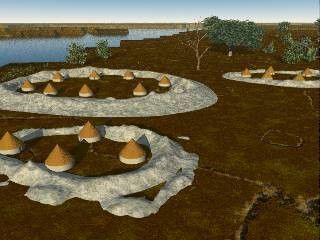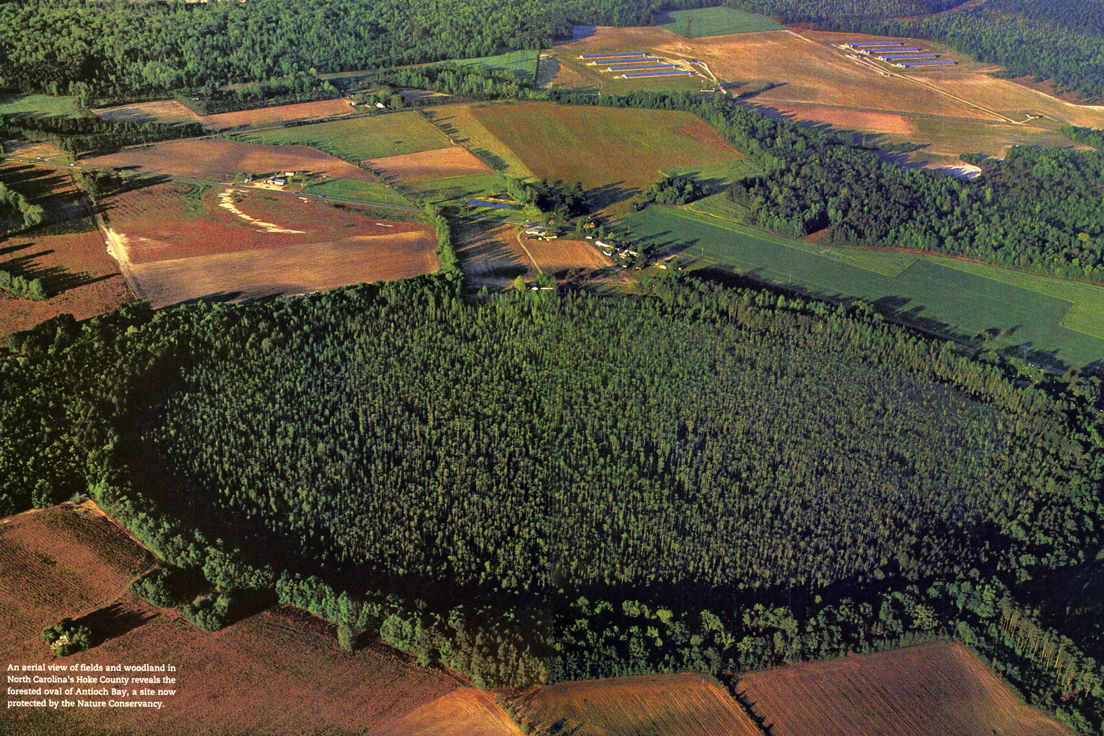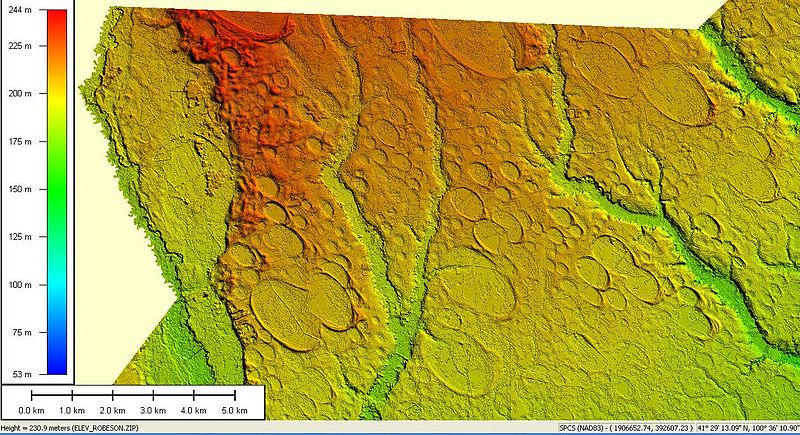It looks like you're using an Ad Blocker.
Please white-list or disable AboveTopSecret.com in your ad-blocking tool.
Thank you.
Some features of ATS will be disabled while you continue to use an ad-blocker.
share:
Source

Well, This is neat.
Any supposedly predates the pyramids because although we like to believe we have a clue, we really have no idea when they were built.
This brings up a lot of interesting questions that are mentioned in the article, like does it take agriculture to make a civilization? Or, was there a civilization we were unaware of that lived in North America at the time?
As I said a lot of interesting questions get brought up with this discovery., So I thought I would bring it here to share with all of you and get others opinions on the matter.
Any thoughts?
Pred...

Six hours southeast of Atlanta off the Georgia coast on Sapelo Island, archaeologists have unearthed the remains of an ancient walled city which predates the construction of Egypt's pyramids. Known as the Sapelo Shell Ring Complex, this ancient city was constructed around 2300 B.C. and featured three neighborhoods each surrounded by circular walls twenty feet in height constructed from tons of seashells. Some of the earliest pottery in North America was also found buried in the remains of this lost city.
The site is quite an enigma because at the time of its construction the Native Americans living in the area were simple hunters and gatherers who had yet to invent agriculture. Many scholars believe agriculture is a prerequisite for civilization. Did these simple tribal people somehow make the leap from hunting-and-gathering to civilization in a single bound producing not only a walled city but also the new technology of pottery without the benefit of agriculture? Or did an already civilized people arrive on the coast of Georgia from elsewhere and, if so, where did they come from and why?
Well, This is neat.
Any supposedly predates the pyramids because although we like to believe we have a clue, we really have no idea when they were built.
This brings up a lot of interesting questions that are mentioned in the article, like does it take agriculture to make a civilization? Or, was there a civilization we were unaware of that lived in North America at the time?
As I said a lot of interesting questions get brought up with this discovery., So I thought I would bring it here to share with all of you and get others opinions on the matter.
Any thoughts?
Pred...
A pre-clovis civilization? Interesting. I would be willing to bet that the settlement was from Europeans.
Just my simple thoughts.
Just my simple thoughts.
Cool find and thanks for sharing. Wonder if there are any tunnels that connect them. Wonder what they were walled up from? The article is neat too.
Could be a branch off of the natives. Some natives probably wanted to stay natural and their gods refuted the new tech and they branched off.
Probably off but it came to mind.
reply to post by predator0187
I think the last paragraph in the article makes the most sense.
Meteors and tsunamis could certainly wipe things away. The other tribes of the area called the Yuchi the "old ones."
yuchi.org...
Fascinating, and it seems the Yuchi's were genuinely unique and claimed they were direct descendants from the sun people. Their description seems to fit the question of who occupied these villages.
Peace,
spec
I think the last paragraph in the article makes the most sense.
The Yuchi also have a legend that they arrived in Georgia after "the old moon broke" and devastated their island homeland. Could they have thought these meteors were pieces of the moon falling to Earth? Could impact tsunamis have devastated their island home in the Bahamas forcing them to flee to the mainland? Only further research will answer the questions
Meteors and tsunamis could certainly wipe things away. The other tribes of the area called the Yuchi the "old ones."
The Yuchi are a very staunchly proud and traditional people, and this alone has kept them from complete assimilation by either the Creek or the Dominant culture. That they are a very distinct people derives from their insistence on their direct descent from the Sun, based in the tradition that their ancestors descended from beings that came down from the Sun and brought them their mound building culture. While they lived among several other tribes, they remained distinct and held themselves, their language and culture separate as well. It remains one of the chief mysteries of the Southeast, how a people could live so intimately with others for so long and maintain a pristine language as an isolate. Languages usually evolve fairly quickly, but Yuchean shows little change over the nearly four hundred years since it was first sampled. The Uchean language has never been certainly classified, and bears little resemblance to any of the known tongues of the Americas. It has not borrowed many words from neighboring languages, and yet has lent quite a few to those neighboring languages. Its structure and etymology bear proof of its having coevolved with the Green Corn Rite. Today it is at the edge of extinction with only a couple of elderly speakers fluent in the Uchean language remaining -- the results of many years of Federal repressive efforts to stamp out Indigenous languages. However, there is a valiant effort for a new generation to learn the language with classes being held and a dictionary finally being published.
yuchi.org...
Fascinating, and it seems the Yuchi's were genuinely unique and claimed they were direct descendants from the sun people. Their description seems to fit the question of who occupied these villages.
Peace,
spec
I have seen these shell rings before,in South Carolina.
shoutaboutcarolina.com...
There are many of them,but that one you posted is awesome.
Thanks ,Pred!
shoutaboutcarolina.com...
There are many of them,but that one you posted is awesome.
Thanks ,Pred!
Yet another piece of evidence illustrating that we still have a lot to learn about our own past. Nice find
reply to post by speculativeoptimist
I think meteors and tsunamis are very telling of ancient times. I think disasters are they reason why gods were invented, IMO.
Still now, watching the tsunami in Japan it just looks amazing. I understand the science behind it and why it happened and yet I still sit there in awe. I could not have imagined what ancient people with no science would have thought. Same goes with total solar eclipses, if you have ever seen one, WOW. That, to me, if I had no idea what was going on, I would attribute to a 'god', and an angry god.
It is very amusing to think what our ancestors thought when equal events happened to them.
Pred...
I think meteors and tsunamis are very telling of ancient times. I think disasters are they reason why gods were invented, IMO.
Still now, watching the tsunami in Japan it just looks amazing. I understand the science behind it and why it happened and yet I still sit there in awe. I could not have imagined what ancient people with no science would have thought. Same goes with total solar eclipses, if you have ever seen one, WOW. That, to me, if I had no idea what was going on, I would attribute to a 'god', and an angry god.
It is very amusing to think what our ancestors thought when equal events happened to them.
Pred...
reply to post by predator0187
why do they always call these 5 acre plots of land cities.....
they are villages at most...
why do they always call these 5 acre plots of land cities.....
they are villages at most...
Originally posted by LucidDreamer85
reply to post by predator0187
why do they always call these 5 acre plots of land cities.....
they are villages at most...
Weren't a heck of a lot of cities back then for comparison....jmoho.
Originally posted by Destinyone
Originally posted by LucidDreamer85
reply to post by predator0187
why do they always call these 5 acre plots of land cities.....
they are villages at most...
Weren't a heck of a lot of cities back then for comparison....jmoho.
Or a big enough population of humans to make what we call 'cities' now. Even though these are small towns in today's terminology, there were no cities as well call them then.
Pred...
well the timeline of Meso American civilization keeps getting pushed back everyday
we know the megalithic ruins of Tiahuanaco and surrounding areas are at least 12,000 years old, it isn't hard for me to believe given that, that there were people in North America building villages at that same time
we know the megalithic ruins of Tiahuanaco and surrounding areas are at least 12,000 years old, it isn't hard for me to believe given that, that there were people in North America building villages at that same time
sorry I don't have a source at hand (computer limitations) but supposedly there are Indian stories of a previous people, dubbed by Manly Wade Wellman
'Shonokins'. legend has it they survive in the back country of Kentucky and West Virginia.
ah, link.
ah, link.
edit on Tue Jan 31 2012 by DontTreadOnMe because: link removed per request of poster
Originally posted by speculativeoptimist
I think the last paragraph in the article makes the most sense.
The Yuchi also have a legend that they arrived in Georgia after "the old moon broke" and devastated their island homeland. Could they have thought these meteors were pieces of the moon falling to Earth? Could impact tsunamis have devastated their island home in the Bahamas forcing them to flee to the mainland? Only further research will answer the questions
Meteors and tsunamis could certainly wipe things away. The other tribes of the area called the Yuchi the "old ones."
Thanks for sharing this story. Fascinating.
This reminded me of the mystery of the 40,000 "Carolina bays" that reach from Florida to Delaware.

What are the Carolina Bays?
Carolina Bays are shallow, oval depressions. They are found throughout the east coast of the United States, from Florida to Delaware. The most Bays are found in southeastern North Carolina, South Carolina, and northeastern Georgia. There are about 40,000 Carolina Bays. The smallest are less than 1 acre and the largest are over 5,000 acres.
source

One theory is that a comet exploded in our atmosphere resulting in these depressions.
Maybe the moon did break.
Peace.
image source
image source
edit on 30-1-2012 by DancedWithWolves because: html for dummies
If these villages were made in 2300 then they do not 'predate' the pyramids. Saqqara the first step pyramid was built 350 years before these villages
and the Giza pyramids 250 years.
Mrs Blonde noted
Actually we don't know that; the dating for Tiahuanaco is between 300-1000 AD, people have been in the area since 1500 BC but the date Posnansky (actually he guessed 12,000 BC) he rather pulled out of his nether regions! However he did so before any of the modern dating techniques were perfected
Mrs Blonde noted
we know the megalithic ruins of Tiahuanaco and surrounding areas are at least 12,000 years old, it isn't hard for me to believe given that, that there were people in North America building villages at that same time
Actually we don't know that; the dating for Tiahuanaco is between 300-1000 AD, people have been in the area since 1500 BC but the date Posnansky (actually he guessed 12,000 BC) he rather pulled out of his nether regions! However he did so before any of the modern dating techniques were perfected
edit on 30/1/12 by Hanslune because: (no reason given)
Would appreciate a more reliable source than a website that allows anyone, in a "blog-like" fashion, to contribute local news stories.
reply to post by kimish
Europeans have never settled anywhere...They just go in and kill all the ingenious populations and take others land.
Europeans have never settled anywhere...They just go in and kill all the ingenious populations and take others land.
reply to post by predator0187
I am the author of the original article at Examiner.com. If you'd like to read more in-depth information about the Sapelo Shell Rings site, visit my article here: www.LostWorlds.org...
The LostWorlds.org article is based on information pulled directly from the PhD thesis project of the archaeologist who researched the site. (Links to all my sources can be found on page two of the article: lostworlds.org... )
The comet/meteor swarm theory isn't associated with the archaeologist's work...that's my own addition pulled from other research sources.
I live just a few miles away from this place and I've tried for years to get the public to take notice of this archaeological site without much luck. So I decided to take a more typical sensationalist approach I see in mainstream media every day. Looks like it worked because tens of thousands of people have now seen this story and shared it on facebook, etc. I've written this same article multiple times but no one was interested when the headline read "shell ring"....I think a grand total of 30 people read it. But call it "ancient walled city" and people click on the headline and read it. This has been very educational for me.
Thanks for the interesting discussion. You can find me on facebook at: www.facebook.com...
I am the author of the original article at Examiner.com. If you'd like to read more in-depth information about the Sapelo Shell Rings site, visit my article here: www.LostWorlds.org...
The LostWorlds.org article is based on information pulled directly from the PhD thesis project of the archaeologist who researched the site. (Links to all my sources can be found on page two of the article: lostworlds.org... )
The comet/meteor swarm theory isn't associated with the archaeologist's work...that's my own addition pulled from other research sources.
I live just a few miles away from this place and I've tried for years to get the public to take notice of this archaeological site without much luck. So I decided to take a more typical sensationalist approach I see in mainstream media every day. Looks like it worked because tens of thousands of people have now seen this story and shared it on facebook, etc. I've written this same article multiple times but no one was interested when the headline read "shell ring"....I think a grand total of 30 people read it. But call it "ancient walled city" and people click on the headline and read it. This has been very educational for me.
Thanks for the interesting discussion. You can find me on facebook at: www.facebook.com...
Talk about making a mountain out of a shell hill..
They are basically rings of garbage around what were either ceremonial grounds, temporary homes.. or yes.. the earliest know egalitarian group in North America. However, evidence doesn't really support the latter.
They are basically rings of garbage around what were either ceremonial grounds, temporary homes.. or yes.. the earliest know egalitarian group in North America. However, evidence doesn't really support the latter.
edit on 30-1-2012 by Furbs because: (no reason given)
